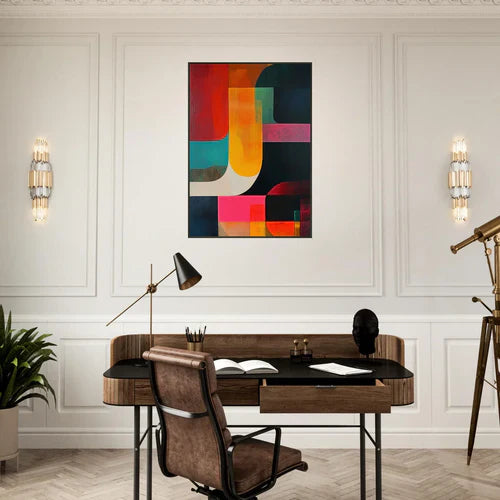
The Art of Balance: Enhancing Spaces Through Thoughtful Design
Share
Art has the transformative power to elevate a space, turning it from merely functional to truly inspiring. But beyond simply filling empty walls, art can harmonize and balance a room, creating an environment that feels cohesive and inviting. When chosen thoughtfully, art doesn't just decorate—it anchors.
Why Balance Matters in Interior Design
Balance in interior design is about creating a sense of visual stability. An imbalanced room can feel chaotic or unsettling, while a balanced one invites comfort and calm. Art plays a pivotal role in achieving this balance, as it influences the flow of energy and guides the eye through the space.
The Role of Art in Spatial Balance
Art contributes to balance in several key ways:
-
Proportional Harmony: The size of an artwork relative to the space and surrounding furniture is crucial. An oversized piece can dominate a room, while a too-small piece might feel insignificant. Selecting art that complements the dimensions of the space helps maintain harmony.
-
Color Cohesion: Art can tie together the color palette of a room. A strategically placed piece can echo the hues of furnishings, walls, or accents, creating a unified aesthetic.
-
Visual Weight: Some artworks, due to bold colors or striking compositions, carry more visual weight than others. Balancing these heavier pieces with lighter elements—such as minimalist furniture or neutral tones—ensures the room doesn't feel overwhelming.
-
Placement Dynamics: Symmetry isn’t always necessary, but thoughtful placement is. For example, pairing a bold, abstract painting with a series of smaller, complementary pieces can create a balanced asymmetry that’s visually dynamic yet harmonious.
Tips for Selecting Art to Balance Your Space
-
Start with the Space’s Purpose: A serene bedroom might benefit from calming landscapes or abstract works in soft hues, while a lively living area can accommodate vibrant, energetic pieces.
-
Consider Scale and Proportion: A gallery wall might suit a long hallway, while a single statement piece could anchor a dining room.
-
Think About Focal Points: Use art to draw attention to a feature of the room, like a fireplace, or to create a new focal point where none exists.
-
Play with Texture and Depth: Sculptural or three-dimensional pieces can add depth and interest, breaking up flat surfaces and contributing to a balanced composition.
The Emotional Impact of Balanced Art
Beyond aesthetics, balanced art impacts how a space feels. It can evoke emotions, inspire creativity, and even influence productivity. A well-chosen piece of art becomes an extension of the people who inhabit the space, reflecting their personality and fostering a sense of connection.
Curating Your Space with Intention
When curating art for a space, think of it as storytelling. What narrative do you want your room to tell? By carefully considering the balance of size, color, and placement, you can craft a story that’s not only beautiful but deeply resonant.
Art has the power to complete a space, harmonizing every element to create an environment that feels just right. Whether you’re designing a cozy home, a bustling office, or a tranquil retreat, let art guide the way to balance and beauty.
